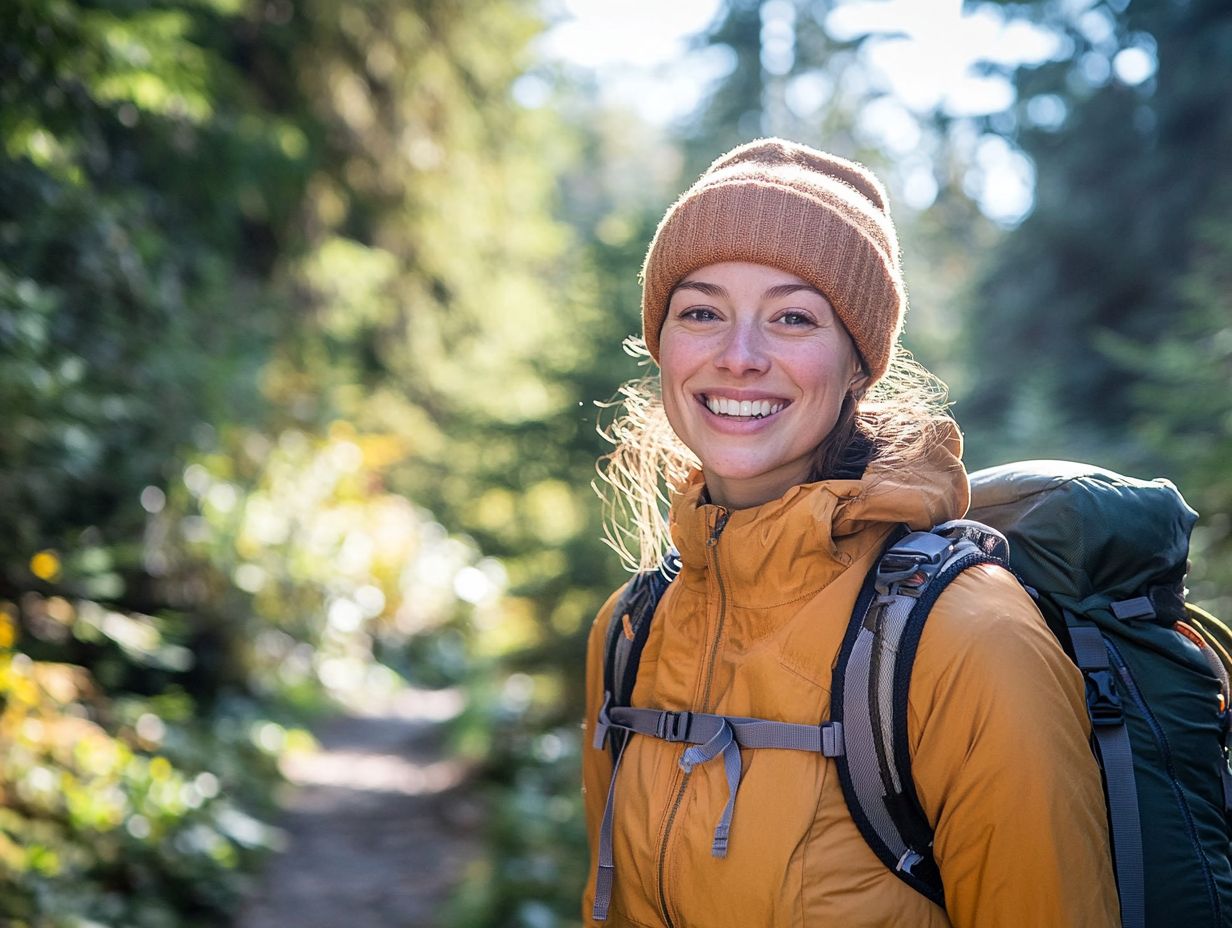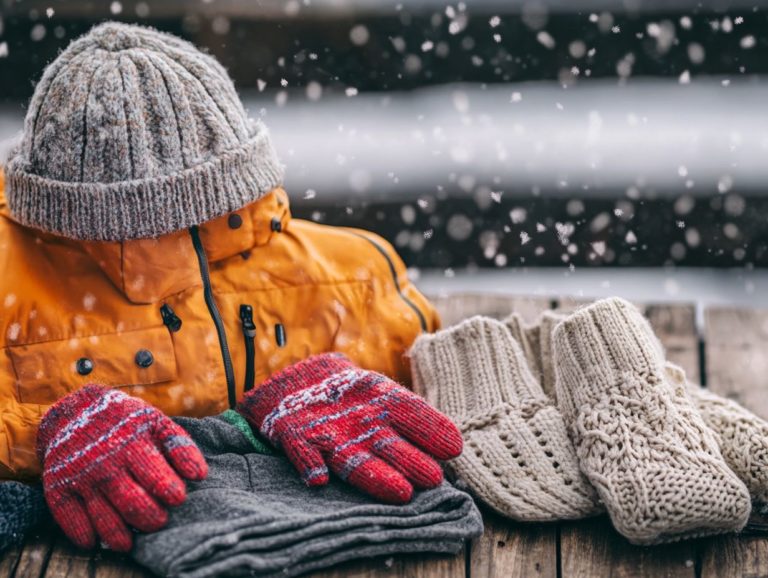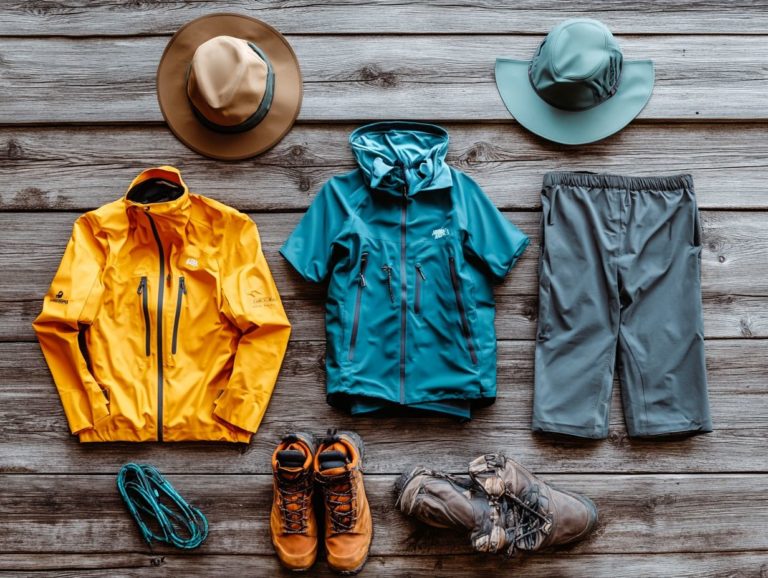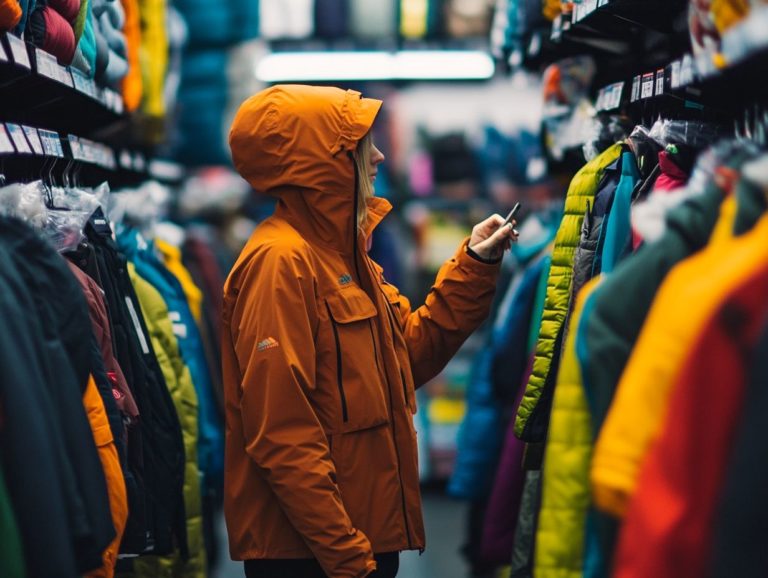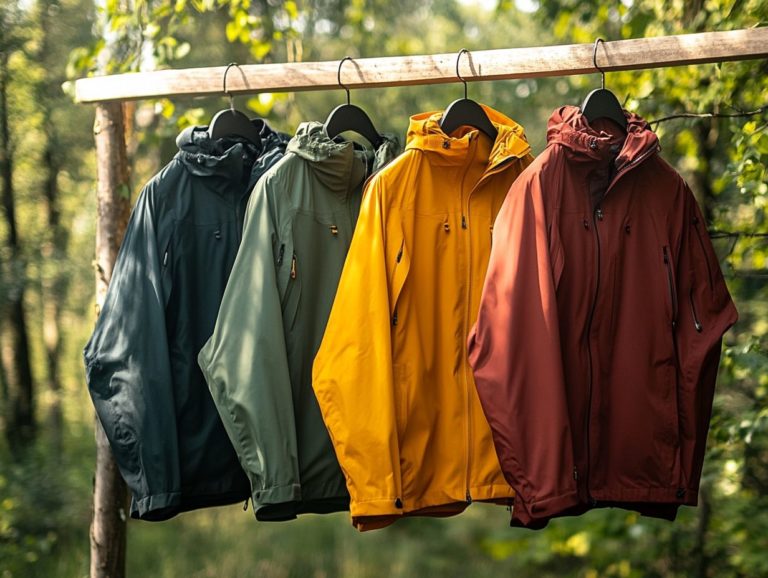How to Layer Your Outdoor Clothing for Maximum Comfort
Layering your clothing is crucial for both comfort and safety, particularly during your outdoor adventures. This guide will walk you through the three essential layers: the base layer for effective moisture management, the middle layer for thermal insulation to keep you warm, and the outer layer that provides weather protection against the elements.
You ll uncover tips on selecting the right fabrics, achieving an impeccable fit, and adjusting your layers to suit various weather conditions. You ll also explore must-have accessories and discover how to care for your layered wardrobe. Get ready to take your outdoor adventures to the next level!
Contents
- Key Takeaways:
- The Three Layers of Clothing
- Tips for Layering Your Clothing
- Additional Considerations
- Frequently Asked Questions
- How do I properly layer my outdoor clothing for maximum comfort and effectiveness?
- Can I layer too many clothing pieces for outdoor activities or make common layering mistakes?
- What materials are best for each layer of outdoor clothing and how do they impact comfort and performance?
- What should I consider when choosing the thickness of my layers and how does it affect temperature adaptability?
- Can I wear cotton as a base layer for outdoor activities, and what are the risks involved?
- What should I do if the weather changes while I’m out for outdoor activities, and how can I ensure effective layering?
Key Takeaways:
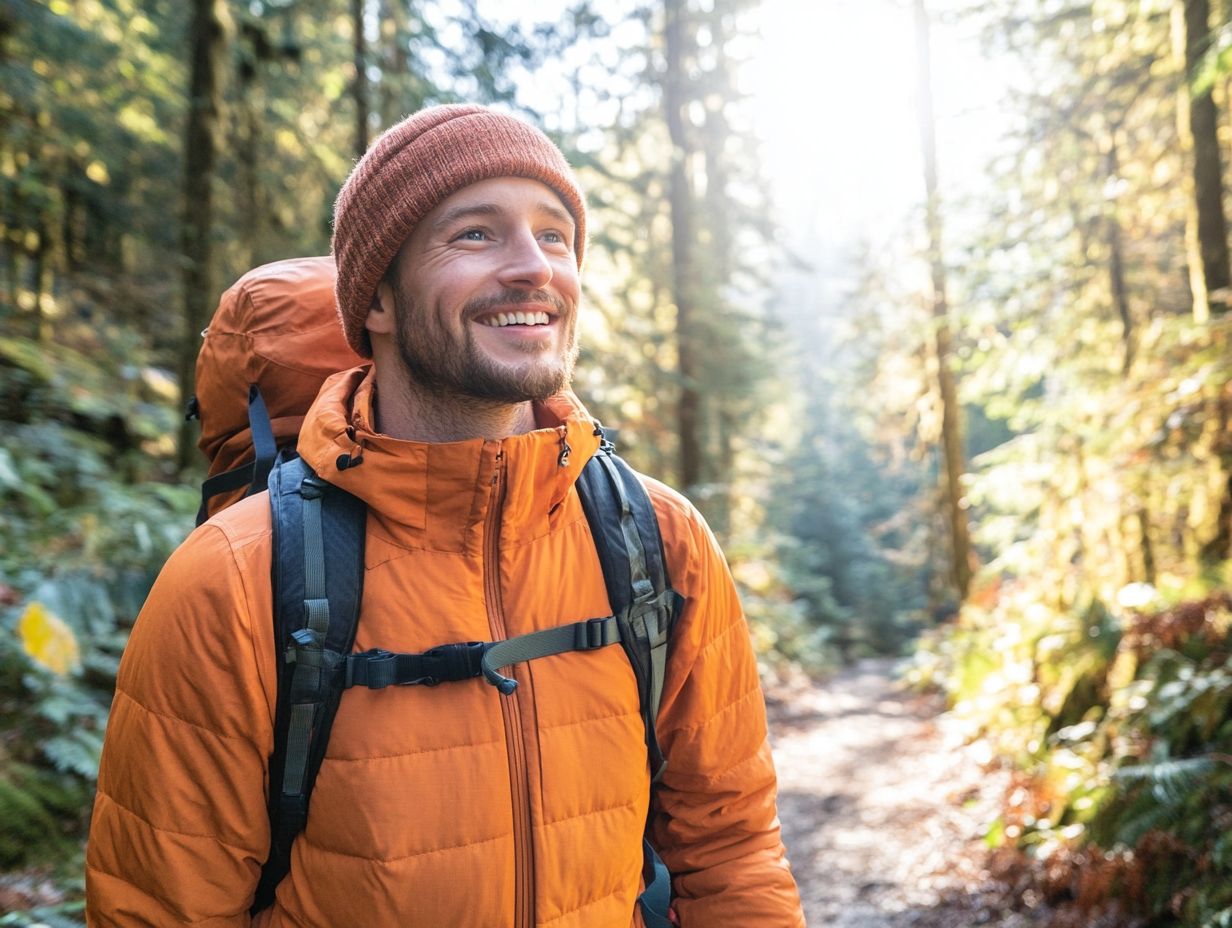
- Choose the right fabrics for each layer: moisture-wicking for the base, insulating for the middle, and waterproof for the outer.
- Ensure a perfect fit for freedom of movement.
- Adjust layers according to the weather and don t forget your accessories!
Why Layering Matters for Your Comfort and Safety
Layering is an essential strategy for outdoor enthusiasts. It ensures both comfort and safety as you navigate varying weather conditions. Mastering the right layering techniques allows for effective moisture management, helping you maintain an optimal temperature whether you’re hiking, skiing, or running.
Understanding the importance of each clothing layer can significantly elevate your outdoor experience. It enhances adaptability and ensures you enjoy your favorite activities without sacrificing performance or safety.
Take hiking in cooler climates, for example. A moisture-wicking base layer pulls sweat away from your skin, preventing that uncomfortable chilly feeling as temperatures fluctuate. Next, a middle layer like a fleece traps heat while remaining breathable, providing the crucial insulation you need.
And don t forget a waterproof outer layer; it acts as your shield against wind and unexpected precipitation, especially during activities like skiing, where sudden weather changes can catch you off guard. This thoughtful layering approach not only boosts your comfort during physical exertion but also significantly lowers the risk of hypothermia or overheating, making your outdoor adventures safer and far more enjoyable.
The Three Layers of Clothing
The three essential layers of clothing for your outdoor adventures consist of the base layer, middle layer, and outer layer. Each serves a unique purpose that enhances your comfort and performance.
The base layer is crafted to wick away moisture, ensuring you stay dry during your activities. The middle layer supplies insulation, helping you maintain optimal temperature control. Finally, the outer layer protects you from the elements think wind, rain, and snow.
Mastering this effective layering system is crucial for anyone who truly enjoys the great outdoors.
Base Layer
The base layer serves as the cornerstone of effective layering. It is expertly crafted to manage moisture through advanced moisture-wicking technologies and breathable fabrics, ensuring your comfort during outdoor activities. This layer is essential for heat management, as it directly interacts with your skin, drawing away sweat and maintaining a pleasant microclimate.
Various materials can fulfill this critical role, each offering distinct benefits tailored to different conditions. Merino wool is excellent for keeping you warm and odor-resistant, making it a superb choice for colder climates. Meanwhile, polyester excels in durability and quick-drying properties, making it ideal for high-intensity sports or warmer environments. Polypropylene, while boasting exceptional moisture-wicking abilities, may not match the comfort levels of wool or polyester.
No matter which material you choose, achieving the right fit is crucial. A snug yet comfortable base layer not only enhances moisture management but also prevents chafing and maximizes your freedom of movement. This way, you can focus on your adventures without any distractions.
Insulating Layer
The insulating layer, often known as the middle layer, is crucial for retaining your body heat while ensuring comfort in chilly weather. Made from materials like fleece and synthetic insulation, this layer creates a thermal barrier that traps heat and allows air to pass through, so you won t overheat during your outdoor adventures.
When choosing insulation, consider the various materials available, each with its own pros and cons. For example, down insulation boasts an impressive warmth-to-weight ratio, making it perfect for skiing. However, keep in mind that it can lose its insulating properties when wet.
On the other hand, synthetic options are generally bulkier but excel in damp conditions, retaining warmth and drying quickly ideal for unpredictable weather. Fleece is lightweight and breathable, but it might not provide the warmth needed in frigid temperatures.
The right insulating layer depends on your specific outdoor pursuits. It s essential for staying comfortable and performing at your best, no matter the weather challenges.
Outer Layer

The outer layer acts as your first line of defense against the elements. It delivers essential weather protection through advanced waterproofing technologies and breathable materials like Gore-Tex and eVent.
This layer ensures you stay dry and ready for action during outdoor activities, preventing external weather conditions from interfering with your performance.
As you explore various options, consider how different fabrics respond to moisture and their ability to wick sweat away from your body. Materials like H2No offer exceptional waterproofing while allowing for ventilation, making them perfect for variable climates.
Understanding the differences between options like nylon and polyester can significantly enhance your experience, whether trekking through a downpour or carving down a snowy slope.
Choosing the right outerwear can make or break your adventure! It not only elevates your comfort but also directly influences your performance, allowing you to fully concentrate on your outdoor experiences.
Choosing the Right Fabrics
Choosing the right fabrics is essential for effective layering. Fabrics play a pivotal role in moisture management, breathability, and overall performance during your outdoor activities.
By understanding the properties of various materials like merino wool, fleece, and synthetic fabrics you can significantly elevate your experience in a variety of weather conditions.
Take merino wool, for example. It excels at temperature regulation and wicks moisture away from your body, making it perfect for hiking and skiing, where temperature fluctuations are common.
Then there’s fleece, which offers outstanding insulation while remaining lightweight. It s ideal for chilly evenings or when the weather throws a curveball.
Synthetic fabrics, such as polyester and nylon, provide superior moisture-wicking properties and quick-drying capabilities, essential for activities that get your heart racing, like running.
By carefully selecting the right fabric based on your activity and climate, you can maximize your comfort and efficiency, allowing you to fully embrace and enjoy your adventures.
Tips for Layering Your Clothing
Effective layering strategies require thoughtful consideration of clothing combinations. Ensure that each layer harmoniously complements the others. This approach optimizes both performance and comfort, regardless of the outdoor conditions you encounter.
By choosing the right materials and ensuring a proper fit, you can achieve exceptional temperature adaptability, allowing you to immerse yourself fully in your outdoor adventures.
Proper Fit and Sizing
Achieving the perfect clothing fit and sizing is crucial for effective layering. It directly influences your comfort and overall performance during outdoor activities. When your outfit fits well, you ll experience better movement, improved moisture management, and a seamless interaction between layers. This keeps you comfortable as the weather shifts.
To maximize the effectiveness of each layer, accurate measurement is essential. When choosing base layers, look for options that are snug yet flexible enough to wick moisture away from your skin without restricting your movement.
Mid-layers should provide adequate room for insulation while still fitting comfortably beneath your outer layers. Those outer layers need to offer enough space for additional thermal layers below. However, they shouldn’t hinder your mobility or allow chilly air to seep in. For more effective techniques, consider exploring layering strategies for year-round adventures.
By taking precise measurements of your chest, waist, and hips, you can select the right sizes that ensure both comfort and protection from the elements. Consulting size guides specific to each brand can refine your fit even more, allowing you to focus on your adventure rather than wrestling with ill-fitting gear.
Layering for Different Weather Conditions
Layering for different weather conditions demands your adaptability and a keen understanding of how to adjust your clothing system based on environmental factors. This ensures you achieve best performance and comfort during your outdoor endeavors.
Whether you’re braving the cold, facing rain, or battling UV exposure, the right layering strategies can truly make all the difference. As an adventurer, selecting the appropriate materials and styles for each scenario will significantly enhance your experience.
In cold weather, for instance, integrate thermal base layers with insulated mid-layers. This combination will keep you warm while still allowing for breathability.
When rain decides to crash your plans, opt for moisture-wicking fabrics and waterproof outer layers. This will keep you dry and comfortable, sparing you from that unpleasant chill that comes with wet clothing.
And don t forget about those sunny days. Lightweight, UV-protective layers that prioritize breathability are essential for shielding yourself from harmful rays while keeping airflow just right.
Master these layering techniques for warmth to adapt effortlessly to changing conditions, ultimately elevating your overall outdoor experience.
Additional Considerations
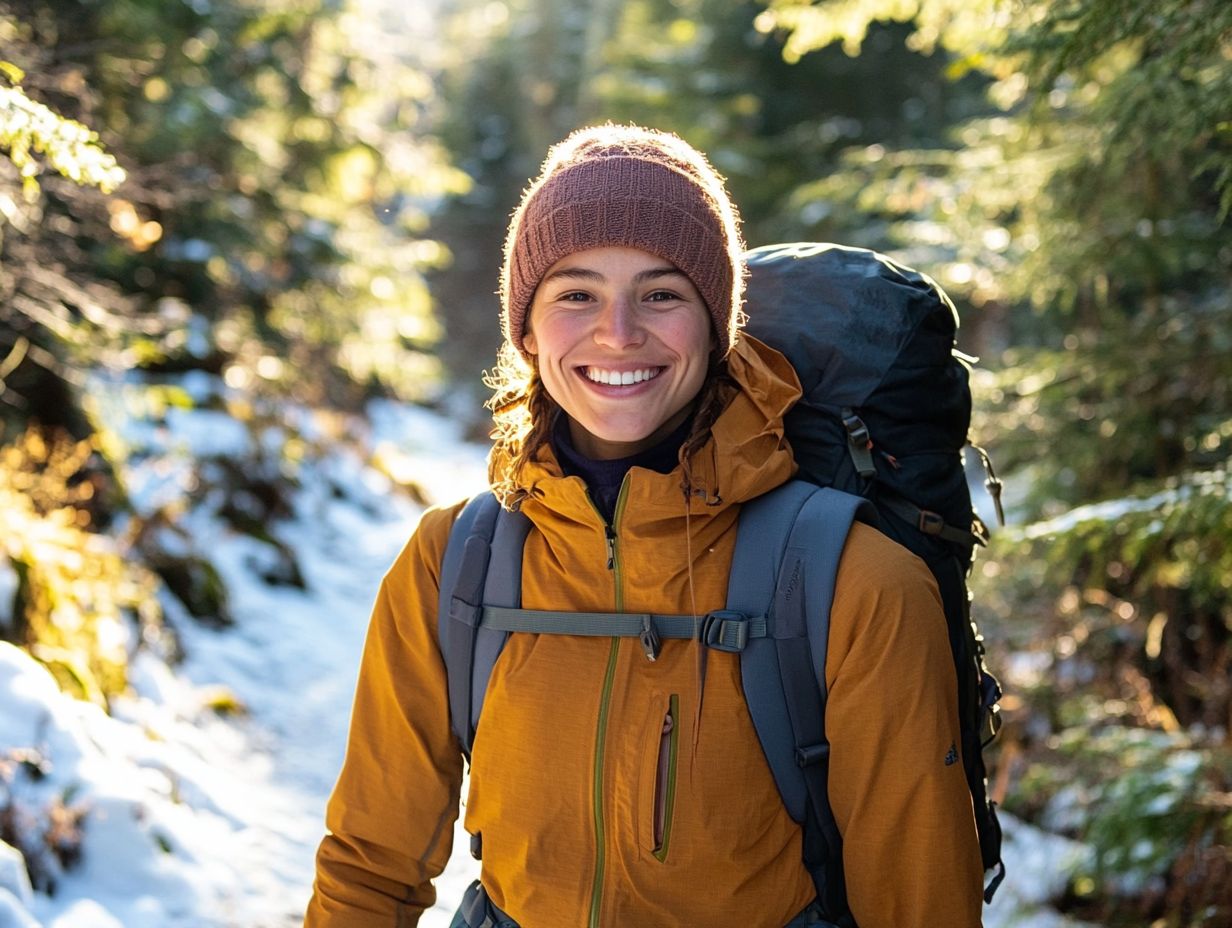
When you think about layering, remember that accessories and the right gear significantly enhance both your comfort and performance. It s crucial to focus on the maintenance and care of your layered clothing. This ensures your outdoor gear remains effective and dependable throughout all your adventures.
Accessories and Gear for Layering
Accessories and appropriate gear elevate the effectiveness of your layering system, offering added comfort and weather protection during outdoor pursuits. From hats and gloves to waterproof pants, selecting the right accessories can vastly enhance your overall outdoor experience.
These essential items do more than just shield you from the elements; they play a key role in moisture management, insulation, and ventilation. Take quality gloves, for example they keep your hands warm while allowing for the dexterity that s crucial for activities like climbing or skiing.
A well-fitted beanie traps warmth, preventing heat loss from your head, while breathable mid-layers effectively wick sweat away from your body, enhancing your performance.
Investing in durable, high-quality outdoor gear ensures you won t have to compromise on protection and comfort. This allows you to fully immerse yourself in your adventures, whether you re hiking through snowy trails or tackling rainy conditions.
Make your gear choices today to enhance your outdoor adventures!
Maintaining and Caring for Layered Clothing
Maintaining and caring for your layered clothing is essential for ensuring the longevity and optimal performance of your outdoor gear. Proper care can prevent wear and tear, enhance moisture management, and preserve the insulating properties of your layering system.
Start with the base layer. It thrives on gentle washing in cold water with a mild detergent, which helps retain its ability to keep you dry. Avoid fabric softeners they can undermine these vital features.
For mid-layers, like fleece or insulated options, you can use a more robust washing cycle, but cold water is still your best choice. Hang drying is preferred over machine drying, as it helps maintain both shape and function.
The outer shell needs special attention during storage. Keep it away from direct sunlight to prevent fading, and ensure zippers are closed to avoid snagging.
Be cautious of common pitfalls, such as storing damp gear, which can lead to mildew. Also, check washing instructions to avoid damaging your specialized fabrics.
Frequently Asked Questions
How do I properly layer my outdoor clothing for maximum comfort and effectiveness?
Ready to layer up for your outdoor adventure? Start with a base layer made of moisture-wicking material to keep you dry. Next, add an insulating layer made of fleece or wool for warmth. Finally, top it off with an outer layer that is both windproof and waterproof.
Can I layer too many clothing pieces for outdoor activities or make common layering mistakes?
Yes, over-layering can cause discomfort. Stick to three layers and adjust according to the weather!
What materials are best for each layer of outdoor clothing and how do they impact comfort and performance?
For the base layer, choose moisture-wicking materials like polyester or merino wool. Fleece and wool are excellent for insulating layers, while for the outer layer, select a material that is both windproof and waterproof, such as Gore-Tex or nylon.
What should I consider when choosing the thickness of my layers and how does it affect temperature adaptability?
The thickness of your layers should depend on the weather and activity level. On colder days or during strenuous activities, opt for thicker layers for added warmth. On milder days or during low-intensity activities, thinner layers may be more comfortable.
Can I wear cotton as a base layer for outdoor activities, and what are the risks involved?
No, cotton is not recommended as a base layer for outdoor activities. It absorbs moisture and takes a long time to dry, which can lead to discomfort and even hypothermia in colder temperatures.
What should I do if the weather changes while I’m out for outdoor activities, and how can I ensure effective layering?
Always be prepared for sudden weather shifts carry extra layers with you. This way, you can add or remove layers as needed to stay comfortable and safe while enjoying your outdoor activities.

